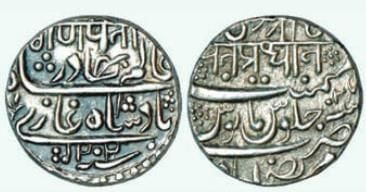The Rise of the Marathas Chapter Notes | Chapter Notes For Class 8 PDF Download
Introduction to the Rise of the Marathas
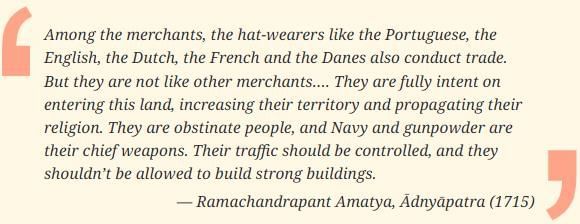
The Marathas, a group from Maharashtra, grew from a community with a rich cultural history into a powerful empire that changed India’s history. Starting with their strong Marathi traditions and the leadership of Shivaji, they fought for self-rule, or Swarajya, against mighty rulers like the Mughals. This chapter explores how their culture, battles, and clever strategies helped them build a great kingdom.
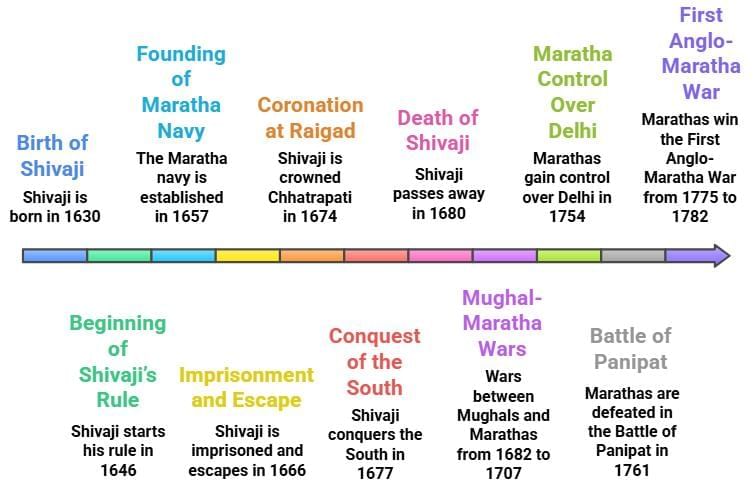
Who Are the Marathas?
The Marathas, primarily from Maharashtra, speak Marathi and have a rich cultural heritage shaped by the Bhakti movement’s devotional poetry. Unified by saints like Dnyaneshwar and Tukaram, they rose as a political force under Shivaji in the 17th century.
Maratha Identity and Language
- The Marathas are people from the Deccan plateau, mainly Maharashtra, known for speaking Marathi, a language with a rich history of stories and poems since the 12th century.
- In the 13th century, the Yadava dynasty ruled Maharashtra with Devagiri (now Daulatabad) as their capital, until the Khilji Sultanate from Delhi took over in the early 14th century.
Bhakti Movement and Cultural Unity
- The Bhakti movement, from the 7th to 17th centuries, focused on devotion to God, with saints like Dnyaneshwar, Namdev, Tukaram, and Ramdas sharing ideas through Marathi songs and poetry.
- These saints translated holy texts like the Upanishads and Bhagavad Gita into Marathi, making them easy for everyone to understand, and some encouraged social and political awareness.
- Their teachings established a strong cultural foundation, enabling the Marathas to unite and later emerge as a powerful political force by the 17th century, particularly under Shivaji’s leadership.
Foundation of Maratha Power and the Rise of Shivaji
Shivaji Bhonsle, born in 1630, transformed the Marathas into a sovereign force through his vision of Swarajya, daring guerrilla tactics, and strategic naval and military victories, culminating in his 1674 coronation as Chhatrapati.
Shivaji’s Early Life and Vision
- Shivaji, born in 1630 to Shahji and Jijabai of the Bhonsle clan, grew up in Pune with a good education and strong values, despite his father’s absence due to serving the Deccan sultanates.
- At 16, he began capturing neglected forts in the Pune region, using guerrilla warfare—quick, surprise attacks with small groups—to defeat larger armies, building the idea of Swarajya (self-rule).
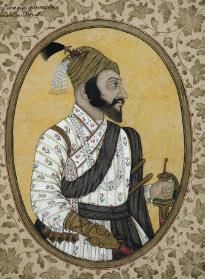 A painting of Shivaji
A painting of Shivaji
Building a Navy and Key Victories
- He created a Maratha navy to protect the west coast, a bold move when even the Mughals and Bijapur Sultanate had weak or no navies, making the Maratha navy’s actions legendary.
- In 1659, Shivaji tricked Bijapur’s general Afzal Khan into a one-on-one meeting at Pratapgad fort, killed him, and used guerrilla attacks to defeat Khan’s army in the forests.
- Shivaji raided Mughal general Shaista Khan’s camp at night with a small team, forcing him to flee after losing fingers, in a daring attack like a modern surgical strike.
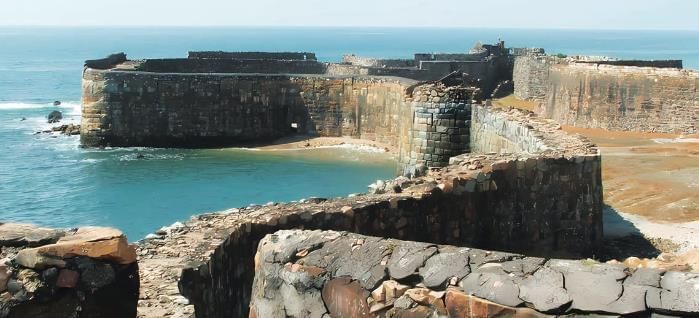 Several naval fortifications built by the Marathas.
Several naval fortifications built by the Marathas.
Surat Raids and Mughal Challenges
- He looted Surat, a rich Mughal port, twice, gaining huge wealth (about one crore rupees) but spared religious places and kind people like Mohandas Parekh, earning fame in newspapers like the London Gazette.
- After losing to Mughal general Jai Singh at Purandar Fort and being forced to give up part of his kingdom, Shivaji was humiliated at Aurangzeb’s court in Agra, but escaped by hiding in gift baskets.
Did you know?
The wāgh nakh played a crucial role in the battle, allowing Shivaji to defeat his opponent effectively.Wāgh nakh or the ‘tiger’s claw’
Coronation and Legacy
- In 1674, he was crowned Chhatrapati at Raigad fort with Vedic rites, starting his own era called Rajyabhisheka Shaka, and later conquered parts of Tamil Nadu and Karnataka for strategic depth.
- Shivaji died at 50 from a fever, but his clever strategies and vision made him a legend, compared to Alexander by Europeans and inspiring leaders like Chhatrasal and poet Bhushan.
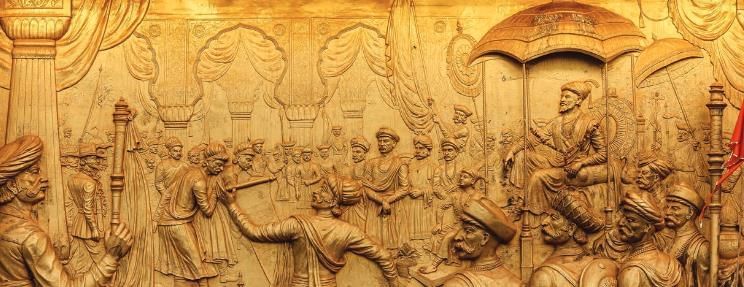 A court scene with Shivaji on his throne receiving visitors
A court scene with Shivaji on his throne receiving visitors
Did you know?
While in the South, Shivaji forbade the Dutch from trading slaves. At the time, most Europeans were capturing and selling Indians as slaves and encountered no opposition from Indian powers, until Shivaji intervened. His stance on this abuse showed his deep concern for his subjects.Shivaji’s Kingdom about 1680
The Marathas After Shivaji
Following Shivaji’s death in 1680, the Marathas, under Sambhaji, Rajaram, and Tarabai, resisted Mughal domination through fierce guerrilla warfare and strategic expansion, paving the way for the Peshwas to transform the Maratha state into a sprawling confederacy.
Sambhaji and the Mughal Invasion
- After Shivaji died in 1680, his son Sambhaji became Chhatrapati, making the Marathas the main obstacle to Mughal control of the Deccan.
- Aurangzeb invaded, conquering Bijapur and Golconda Sultanates, then captured and brutally executed Sambhaji, taking the Maratha capital, Raigad.
Rajaram and Tarabai’s Resistance
- Rajaram, Shivaji’s other son, became Chhatrapati and fled to Gingee in Tamil Nadu, spreading the Mughal-Maratha conflict to South India.
- The Marathas fiercely defended their forts and often defeated the Mughals in battles, preventing Aurangzeb from fully controlling the Deccan until his death.
- Tarabai, Rajaram’s queen, led the Marathas to invade Mughal territories, conquering large parts of India and keeping Maratha power strong.
Peshwa Power and Expansion
- The Maratha state became less centralised, with regional chiefs and the Peshwa (prime minister) gaining more power than the Chhatrapati.
- Peshwa Bajirao I and his son Nanasaheb Peshwa led the Marathas to control large parts of India, including Lahore, Attock, and Peshawar (now in Pakistan).
- Despite a major defeat at Panipat in 1761 against the Afghans, the Marathas recovered under Peshwa Madhavrao I and recaptured Delhi in 1771 under Mahadji Shinde.
Challenges and British Conquest
- The Marathas ruled well but faced issues as regional chiefs gained more power, sometimes acting against Shivaji’s values, like causing harm during their 10-year campaign in Bengal.
- In the late 18th century, the Marathas were the main rivals to the British, but internal disunity and British organisational and technological advantages led to their defeat in three Anglo-Maratha wars (1775–1818).
- The British effectively took control of India from the Marathas more than from the Mughals or other powers.
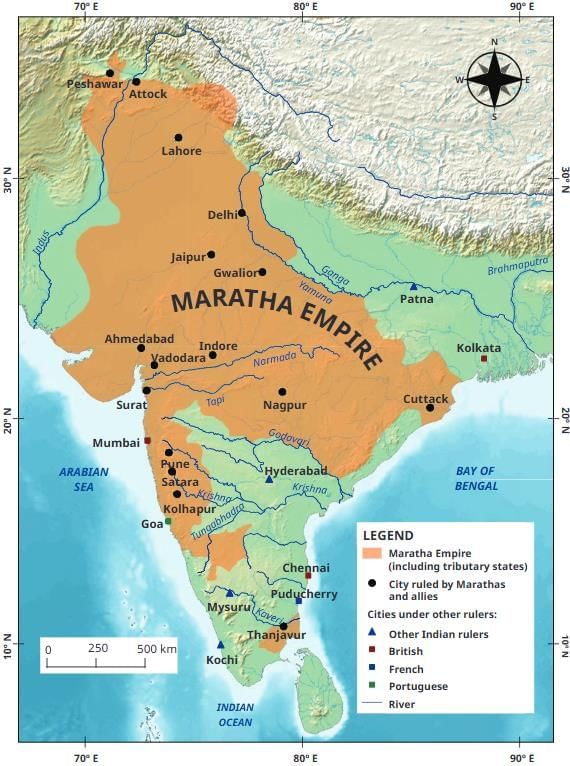 The extent of the Maratha empire in 1759.
The extent of the Maratha empire in 1759.
Did you know?
Nana Phadnavis, a powerful official under the Peshwas, is credited with organising the first pan-Indian anti-British alliance. He even united with old adversaries like Hyder Ali of Mysore and the Nizam of Hyderabad in this endeavour.British officer surrendering after the first Anglo-Maratha war.
Maratha Administration
Shivaji’s visionary administration laid the foundation for a robust Maratha Empire, blending centralised governance, innovative military strategies, and a powerful navy, while fostering trade and a fair judicial system that endured into the 18th century.
Civilian Administration
- Shivaji created a centralised government, removing hereditary posts and land grants, paying officials salaries from the state treasury to keep them loyal.
- He transferred officials often to prevent them from gaining too much power and challenging the king.
- Shivaji supported soldiers’ families by giving pensions to widows and offering military jobs to their sons, showing care for his people.
- He had a council of eight ministers, called the Ashta Pradhana Mandala, to help manage the kingdom efficiently.
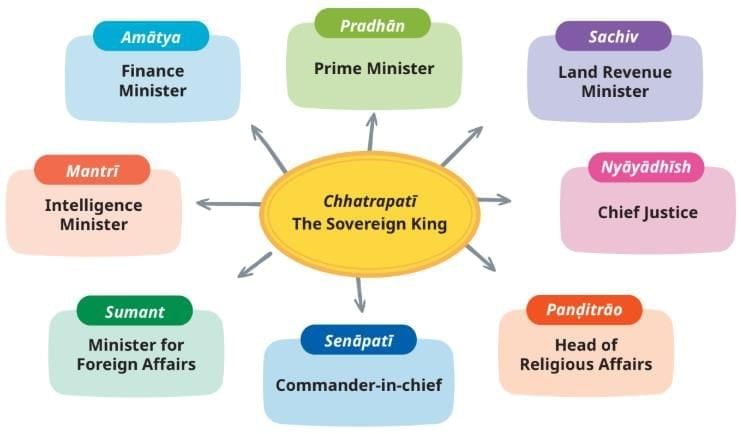 aṣhṭa pradhāna manḍala, or council of eight ministers
aṣhṭa pradhāna manḍala, or council of eight ministers - The Marathas collected taxes called chauth (25%) and sardeshmukhi (10% extra) from provinces they protected but didn’t directly rule, an arrangement approved by the Mughals, leading some provinces to join the Maratha Empire.
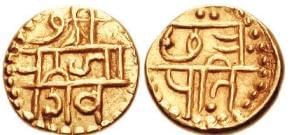 Shivaji minted coins in his own name
Shivaji minted coins in his own name
Did you know?
In the 18th century, the Marathas adopted the popular Mughal coin style but added their own cultural flair. The rare Gaṇapatī-Pantapradhān rupee, minted by the Patwardhans in the early 19th century, features Devanagari and Persian scripts—invoking Lord Gaṇapati on one side and declaring loyalty to the Peshwa on the other. It was more than currency—it was a symbol of power and devotion.
Military Administration
- The Maratha army had three parts: infantry (foot soldiers), cavalry (horse riders), and navy, with cavalry split into bargirs (state-funded) and shiledars (self-funded).
- In the 18th century, Marathas adopted European-style disciplined troops and artillery, with Mahadji Shinde building a large modern army.
- They used swords, lances, and guns, and by 1770, they also used metal tube rockets in battles, starting from Shivaji’s time.
- Forts were key to Maratha power, used to control important routes and protect the army during guerrilla warfare, as explained by Shivaji’s minister Ramachandrapant Amatya in his work Adnyapatra.
- He stated that forts are the foundation of a strong state—without them, territories fall easily to invaders. Even when powerful enemies like Aurangzeb attacked and overran major kingdoms like Bijapur and Bhaganagar, it was the forts that enabled the Maratha state to endure relentless assaults for decades.
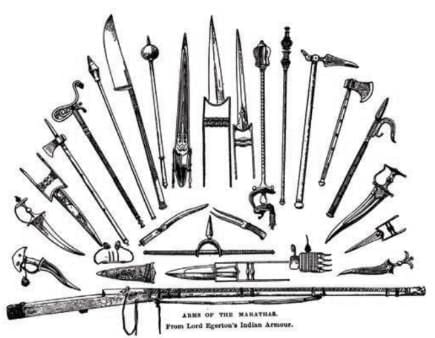 Weapons used by the Marathas.
Weapons used by the Marathas.
Maritime Supremacy
- Shivaji built a navy to secure the west coast, and in the 18th century, Kanhoji Angre led it to win many battles using clever geography and tactics, despite less advanced ships.
- Europeans forced Indian ships to buy trade passes (cartaz), but the Marathas challenged this by demanding passes from Europeans, frustrating them and earning Kanhoji Angre the label of “pirate.”
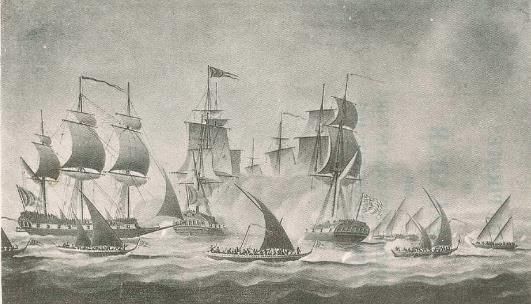 Maratha ships attacking English ships
Maratha ships attacking English ships
Did you know?
In 1665, four ships from Shivaji’s fleet reached Muscat, the capital of Oman. The ruler there captured them and arrested the men on board. He also prepared a few ships to attack Shivaji’s coastal possessions. But, on hearing that Shivaji’s Navy contained more than a hundred ships, he retreated inside the harbour with his ships.
Judicial System
- The Marathas had a fair judicial system, with minimal capital punishment, and local panchayats (groups of officials and respected men) deciding on justice.
- People could appeal to a Maratha chief if they disagreed with a panchayat’s decision.
- In big towns like Pune and Indore, a kotwal (police) was appointed to maintain law and order.
Trade Networks
- Shivaji encouraged trade, owning ships that carried goods like gold and textiles to faraway ports like Mocha (Yemen), Muscat (Oman), and Malacca (Malaysia).
- The Marathas built and maintained roads, bridges, and a ferry network in places like Odisha for river transport in the 18th century.
Cultural Revival
Shivaji’s Swarajya ignited a vibrant cultural revival, promoting Marathi and Sanskrit, restoring Hindu traditions, and inspiring his successors to champion local arts and religious practices across India.
Shivaji’s Cultural Contributions
- Shivaji’s vision of Swarajya was shown in his seal, which used a Sanskrit inscription instead of Persian, saying his rule was for the people’s welfare, like a growing moon.
- He commissioned the Rajya-Vyavahara-Kosha, a treatise replacing Persian words with Sanskrit ones in diplomacy, boosting the Marathi language.
- As a devout Hindu, Shivaji respected other religions, rebuilt damaged temples, and promoted Sanskrit and Marathi literature, religious institutions, and traditional arts.
- His success in defeating mighty empires showed Indians they could build and manage their own empire, inspiring a revival of ancient Indian culture and values.
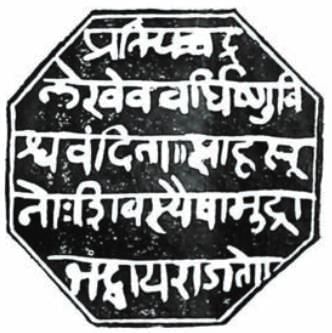 Shivaji’s seal
Shivaji’s seal
The mighty Maratha women
- Tarabai was a bold and strategic warrior queen who led the Maratha Empire in the early 18th century after her husband Rajaram’s death.
- Sensing that Aurangzeb’s focus on the Deccan left northern India vulnerable, she launched powerful Maratha campaigns into Mughal territories.
- Her leadership and sharp military tactics laid the foundation for the Maratha expansion into the north and safeguarded the empire during one of its most challenging times.
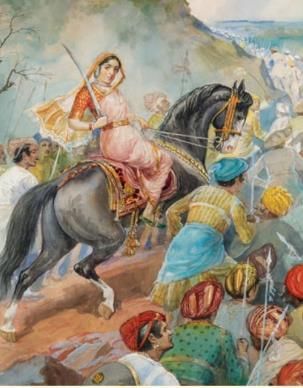 Tarabai in battle (Painting)
Tarabai in battle (Painting)
- Ahilyabai Holkar, a formidable ruler of the Holkar dynasty, governed central India with wisdom and compassion for three decades.
- Despite personal tragedy, she remained a strong administrator and deeply cared for her people.
- A devout patron of religion and culture, she rebuilt sacred sites like the Kashi Vishwanath temple in Varanasi and the Somnath temple in Gujarat.
- She also championed public welfare projects and revived the Maheshwar handloom tradition, leaving behind a lasting legacy of spiritual and cultural resurgence.
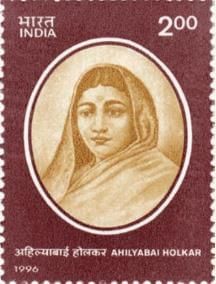 A postage stamp honouring Ahilyabai Holkar
A postage stamp honouring Ahilyabai Holkar
Cultural Support by Successors
- Shivaji’s successors, like the Bhonsles of Nagpur, supported local culture, reviving the worship of Jagannath at Puri in Odisha, which had been disrupted under Mughal rule.
- Maratha women, such as Tarabai and Ahilyabai Holkar, made significant cultural contributions, which are detailed further in the chapter.
Did you know?
The Moḍī script (a cursive form of Devanagari) was the main script used by Marathas for their correspondenceA sample of Chhatrapati Shahu Maharaj’s handwriting in the Moḍī script
In Focus: Thanjavur
- Ekoji, Shivaji’s half-brother, conquered Thanjavur in Tamil Nadu in the late 17th century, starting Maratha rule and creating a rich, mixed culture of Tamil, Telugu, and Marathi influences.
- Serfoji II, a notable Thanjavur ruler, knew many Indian and European languages and wrote a Marathi play, Devendra Kuravanji, describing world geography.
- He supported musicians, helping shape modern Carnatic music and the early development of the classical dance Bharatanatyam.
- Serfoji set up the Dhanwantari Mahal, a medical centre offering free treatment using Indian and Western methods, and started India’s first printing press by a native ruler.
- He inscribed the Bhonsle family history on the Brihadishwara temple walls, creating one of India’s largest single inscriptions for future generations.
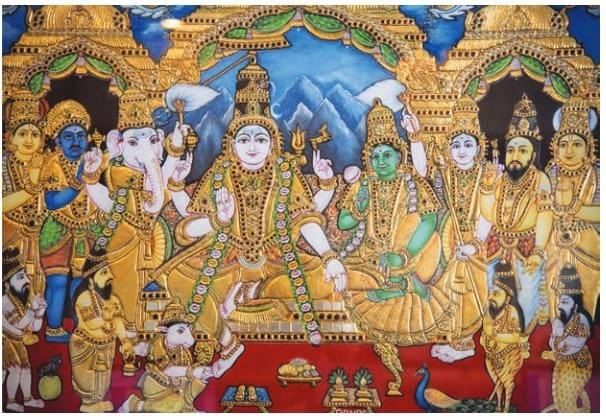 A traditional Thanjavur style painting
A traditional Thanjavur style painting
The Maratha Legacy
- The Marathas challenged Mughal dominance, building the largest Indian empire before British rule, controlling much of central and northern India.
- They introduced efficient governance and revived Hindu traditions without discriminating against other religions, strengthening local culture.
- Their fight for Swarajya inspired Indians to believe in self-governance, planting early seeds for India’s freedom movement against foreign rule.
Key Points to Remember: Before We Move On
Chhatrapati Shivaji Maharaj founded the Maratha kingdom in the 17th century.
The Marathas' long resistance to Mughal rule helped them expand across India in the 18th century.
The British gained control of India mainly by defeating the Marathas, more than any other Indian power.
Forts were central to Maratha power; they controlled hundreds of forts, strengthening their regional control.
The Marathas had a strong navy, which resisted European naval dominance despite lacking modern technology.
They also sparked cultural pride and revival in different parts of India, encouraging innovation and confidence.
FAQs on The Rise of the Marathas Chapter Notes - Chapter Notes For Class 8
| 1. What were the key factors that contributed to the rise of the Marathas as a powerful force in India? |  |
| 2. Who was Shivaji, and what were his contributions to the Maratha Empire? |  |
| 3. What role did the geography of the Deccan Plateau play in the rise of the Marathas? |  |
| 4. How did the Marathas influence the political landscape of India during their rise? |  |
| 5. What were some of the administrative reforms introduced by Shivaji and their impact on the Maratha Empire? |  |


